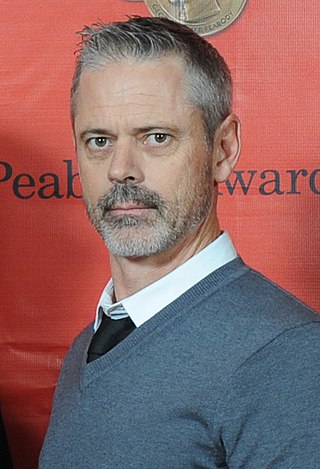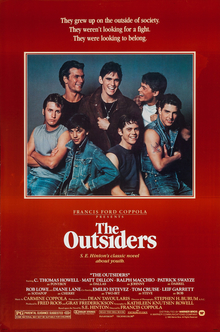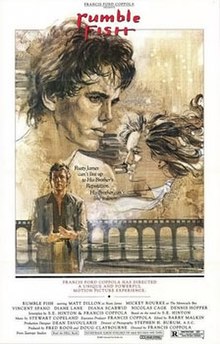
Francis Ford Coppola is an American film director, producer, and screenwriter. He is considered one of the leading figures of the New Hollywood film movement of the 1960s and 1970s and is widely considered one of the greatest directors of all time. He is the recipient of five Academy Awards, six Golden Globe Awards, two Palmes d'Or, and a British Academy Film Award (BAFTA).

Christopher Thomas Howell is an American actor. He has starred in the films Soul Man, The Hitcher, Grandview U.S.A., Red Dawn, Secret Admirer, and The Outsiders. He has also appeared in Gettysburg and Gods and Generals as Thomas Chamberlain; E.T. the Extra-Terrestrial; The Amazing Spider-Man; Justice League: The Flashpoint Paradox; and Suicide Squad: Hell to Pay.
Susan Eloise Hinton is an American writer best known for her young-adult novels (YA) set in Oklahoma, especially The Outsiders (1967), which she wrote during high school. Hinton is credited with introducing the YA genre.

Matthew Raymond Dillon is an American actor. He has received various accolades, including an Academy Award nomination and Grammy nomination.

Philip Andre "Mickey" Rourke Jr. is an American actor and former professional boxer who has appeared primarily as a leading man in drama, action, and thriller films.

The Outsiders is a coming-of-age novel by S.E. Hinton published in 1967 by Viking Press. The book details the conflict between two rival gangs of White Americans divided by their socioeconomic status: the working-class "Greasers" and the upper-middle-class "Socs". The story is told in first-person perspective by teenage protagonist Ponyboy Curtis, and takes place in Tulsa, Oklahoma in 1965, although this is never explicitly stated in the book.

That Was Then, This Is Now is a coming-of age, young adult novel by S. E. Hinton, first published in 1971. Set in the 1960s, it follows the relationship between two brothers, Mark Jennings and Bryon Douglas, who are foster brothers, but find their relationship rapidly changing and deteriorating. The book was later adapted into a 1985 film starring Emilio Estevez and Craig Sheffer.

Heather Elizabeth Langenkamp is an American actress, writer, director, disc jockey, and producer. Although she has acted in many film genres, she is primarily known for her work in horror films, in addition to her work on television sitcoms. Langenkamp has been referred to as a scream queen and was inducted into the Fangoria Chainsaw Hall of Fame in 1995.

Stanard "Stan" Ridgway is an American singer-songwriter, and film and television composer known for his distinctive voice, dramatic lyrical narratives, and eclectic solo albums. He was the original lead singer and a founding member of the band Wall of Voodoo.

Santino "Sonny" Corleone is a fictional character in Mario Puzo's 1969 novel The Godfather and its 1972 film adaptation.
This is a summary of mass communications media in Tulsa, Oklahoma.

Daniel O'Connor, better known as Danny Boy or Danny Boy O'Connor, is an American rapper, art director, and the executive director of The Outsiders House Museum. O'Connor spent his childhood in New York, before moving to Los Angeles in the 1980s. In the 1990s, O'Connor co-founded the rap group House of Pain, with fellow rapper Erik Schrody (Everlast) and DJ Leor Dimant. Based on their cultural heritage they fashioned themselves as rowdy Irish-American hooligans. O'Connor played the role of art director, designing logos, branding, hype man, and co-rapper. In 1992, with the singles "Jump Around" and "Shamrocks and Shenanigans", their self-titled debut album, also known as Fine Malt Lyrics, went platinum.

The Outsiders is a 1983 American coming-of-age crime drama film directed by Francis Ford Coppola. The film is an adaptation of the 1967 novel of the same name by S. E. Hinton and was released on March 25, 1983, in the United States. Jo Ellen Misakian, a librarian at Lone Star Elementary School in Fresno, California, and her students were responsible for inspiring Coppola to make the film.

Tex is a novel by S. E. Hinton, published in 1979. The book takes place in the same universe as Hinton's first book The Outsiders, but in a rural town called Garyville, Oklahoma, a fictional suburb of Tulsa.

Gian-Carlo Coppola was an American film producer and actor. He was the oldest child of set decorator/artist Eleanor Coppola and film director Francis Ford Coppola, and brother to screenwriter/producer Roman Coppola and director Sofia Coppola.
The Outsiders is an American drama series that aired from March 25 to July 22, 1990 on Fox. Based on the characters from the 1967 novel of the same title by S. E. Hinton, the series' executive producer was the 1983 film's director Francis Ford Coppola.

Rumble Fish is a 1975 novel for young adults by S. E. Hinton, author of The Outsiders. It was adapted to film and directed by Francis Ford Coppola in 1983.
Rusty James is a fictional character in author S. E. Hinton's 1975 novel Rumble Fish. The book was adapted to film and directed by Francis Ford Coppola in 1983. In the film, Rusty-James is played by Matt Dillon. In the book, Rusty James is a tall 14 year old kid in Junior High School with dark red hair and Hershey brown eyes.

The Outsiders House Museum is a museum in Tulsa, Oklahoma, about Francis Ford Coppola's coming-of-age movie,The Outsiders (1983), and the 1967 novel by the same name it adapts by S. E. Hinton. It aims to preserve the house which served as the primary film set for the Curtis Brothers. The museum was created by hip-hop artist Danny Boy O'Connor, who is a long-time fan of The Outsiders.

The Outsiders is a 2023 musical with music and lyrics by Jonathan Clay and Zach Chance from the folk rock band Jamestown Revival alongside Justin Levine and a book by Adam Rapp and Levine. It is based on the novel The Outsiders, first published in 1967 and written by S. E. Hinton, and on its 1983 film adaptation written by Kathleen Rowell and directed by Francis Ford Coppola. In 1990, playwright Christopher Sergel published a straight play version of the story.
















